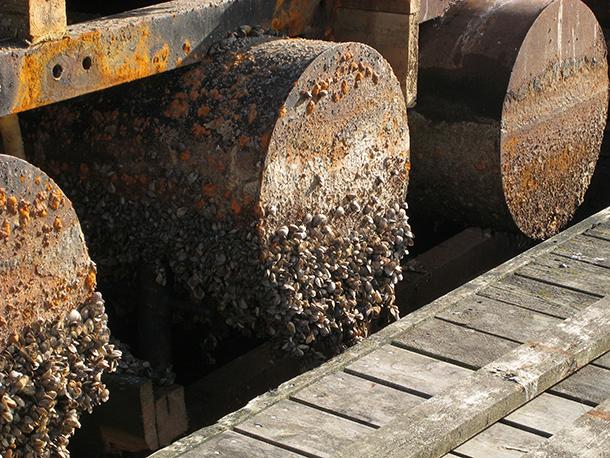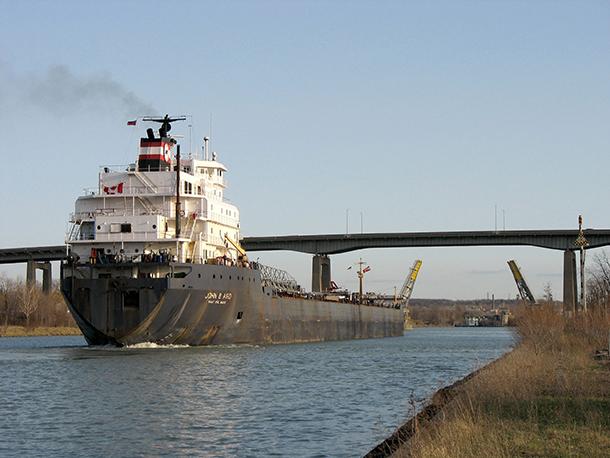The death and life of the Great Lakes
The John B. Aird passes through the Welland Canal, the passage along the St. Lawrence Seaway connecting the Great Lakes to the Atlantic Ocean.
When the St. Lawrence Seaway opened on April 24, 1959, it created a link from the Great Lakes to the sea along the US-Canadian border — the fulfillment of a dream for the heartland of the continent. It also created an ecological nightmare no one anticipated.
Environmental journalist Dan Egan details the history of the Seaway and the modern problems it created in his new book, "The Death and Life of the Great Lakes."
“The whole idea behind the St. Lawrence Seaway was, essentially, to carve an American Mediterranean Sea out of the middle of the continent by basically blasting a shipping channel between the Great Lakes and the Atlantic Ocean,” Egan explains.
The Great Lakes collectively span 94,000 square miles, but “they were as isolated as a pond in the middle of the woods,” Egan says, because no ships from the Eastern Seaboard could get to them.
Its creators hailed the Seaway as a modern miracle. Egan believes that it was obsolete the day it opened.
“They built it on the cheap. The size of the locks and the channels reflected the size of the world's fleet in the 1930s, not in the late 1950s or early 1960s,” Egan explains. “The Seaway opened in 1959, and the container revolution took off almost simultaneously. That demanded bigger and bigger boats, so the Seaway got squeezed aside.”
The other problem was ice. “You can't have a world-class shipping corridor that shuts down for three months of the year,” Egan says. “In this world of just-in-time delivery, you need fast, dependable, predictable, perennial deliveries, and you can't do that with a navigation route that is choked by ice.”
What was left, then, was a kind of “boutique shipping industry,” Egan says. On average today, fewer than two ships per day come into the Great Lakes through the St. Lawrence Seaway during the nine-month shipping season.
Ships that once came down the Seaway often didn't carry high-value cargo. But they did carry something else: invasive species — from alewives to zebra mussels — that have hitched rides in the ballast tanks of ocean freighters. Zebra and quagga mussels, tiny little mollusks from the Caspian Sea basin, now blanket the bottom of the Great Lakes, Egan says.

As the agricultural center of North America flourished and sent increasing pesticide and nutrient runoff from corn and wheat fields into the Great Lakes, the consequences of this new "biological pollution" became clear.
Look at what happened to Lake Erie in 2014, Egan says: 500,000 people lost their drinking water because of an outbreak of toxic algae called Microcystis, which produces a toxin called microcystin.
“Microcystin occurs naturally in the Great Lakes, but these mussels basically eat everything but that algae, so the algae has no competition,” Egan explains. “It's a pollutant as toxic, dangerous and problematic as anything that can come out of an industrial pipe or smokestack.”
As opposed to “traditional” pollution, which can be slowed or stopped by capping a smokestack or plugging a pipe, “this new biological pollution doesn't decay or disperse. It breeds,” Egan says.
“It doesn't mean that Lake Erie's water is going to be poisonous from here on out every late summer,” Egan says. “There are things we can do. Specifically, we can reduce the amount of phosphorous going into the lake. But the mussels are here, and we're really going to just have to learn to live with them.”
Invasive species have cost cities around the Great Lakes hundreds of millions, maybe billions, of dollars, and the Midwest does a lot more trade via railways from East Coast harbors than from ships in their own ports. So, why do these lake economies continue to keep their harbors open to the risk of foreign vessels?
Because, despite its problems, the Seaway and the Great Lakes shipping channel are important navigation corridors, Egan says, and the vast majority of goods are moved by local boats. These boats don’t bring in invasive species.
Closing off the Seaway to overseas shipping, on the other hand, is an idea that should be on the table, Egan believes. He suggests a cost-benefit analysis that compares the relatively few ships coming up the Seaway to the ecological and economic impacts that invasive species have had, not just on the Great Lakes, but across the continent.
“When you think of the number of reservoirs and boat ramps and boats out West, and the idea that these people are drawing a line around each water body, doing everything they can to stop a contaminated boat from contaminating the next pond, lake or reservoir, it's almost an impossible task,” Egan says.
“Then, if you go [back east], across the continent, and you look at the boats that have brought in this trouble, every single one of them has to go through this exquisitely tight pinch point, called the St. Lambert Lock. It's the first lock on the St. Lawrence Seaway, and it's 80 feet wide. If you stop trouble there, you save a continent's worth of trouble.”
This article is based on an interview that aired on PRI’s Living on Earth with Steve Curwood.
